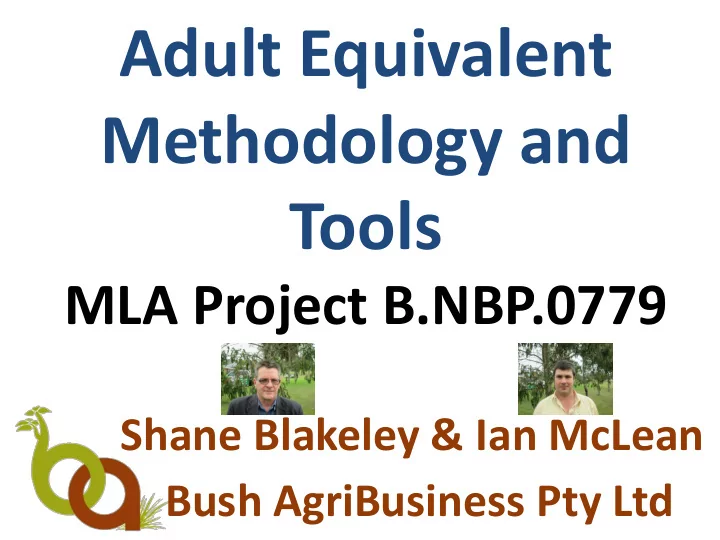

Adult Equivalent Methodology and Tools MLA Project B.NBP.0779 Shane Blakeley & Ian McLean Bush AgriBusiness Pty Ltd
AE Methodology & Tools • Why is this important? • How was it developed? • What does it do? • What is an Adult Equivalent? • How do you use it?
AE Methodology & Tools, B.NBP.0779 Why is this important? The term ‘AE’ is; – Widely used – Not consistently defined or applied. • There is no clarity on the relative AE rating of animal classes or the treatment of weight gains, pregnancy or lactation. • There is a need to have an accurate and defendable methodology for calculating grazing loads, stocking rates and detailed financial analysis.
AE Methodology & Tools, B.NBP.0779 Why is this important? Common usage of breeders or number of head describing carrying capacity or value are problematic; 1. “It will run 2,000 breeders” 3,450 AE if selling weaners, 5,660 AE if selling bullocks 2. “It will carry 1,000 head”
“It will carry 1,000 head” Hereford Bullocks, growing from 425kg-575kg over 12 months. 1.52 AE/hd = 1,520 AE Bos taurus Table
“It will carry 1,000 head” Brahman Weaner Steers, growing from 175kg-325kg over 12mths. 0.82 AE/hd = 820 AE Bos indicus Table
AE Methodology & Tools, B.NBP.0779 How was it developed? • Initial concept developed privately using MAFF tables • Discussed concept with MLA • MLA supported development of concept, basing it on the Australian Feeding Standards. (Nutrient Requirements of Domesticated Ruminants, CSIRO 2007)
AE Methodology & Tools, B.NBP.0779 How was it developed? An AE is a unit of animal, quantified in terms of energy demand and based on animal specific variables. It is not based on animal-pasture variables or other animal-environment interactions. Scarnecchia
APPROACH Minimum number of animal specific variables for maximum accuracy. Applied to Nutrient Requirements of Domesticated Ruminants (Feeding Standards) To give Energy demand of animals relative to the Animal Equivalent standard
AE Methodology & Tools, B.NBP.0779 How was it developed? Variables that determine energy requirements. – Age – Breed – Sex – Weight – Weight gain – Pregnancy status – Lactation status – Weaning age & weight – Activity? – Diet Quality?
AE Methodology & Tools, B.NBP.0779 How was it developed? Issues with environmental interactions • Diet Quality Environmental interaction, but affects ME requirement. Relatively narrow range of diet quality across Northern Australia and fixing it has no material affect on absolute or relative AE ratings. Fixed at 7.75 MJ ME/ Kg DM for all calculations • Distance Walked Affects energy required for activity Cattle walk a similar distance each day, irrespective of paddock size, grazing radius and number of waters Fixed at 7.0km /day for all calculations
Diet Quality 2,000 NIRS samples from Cashcow project and Beef CRC/QDAFF Q1 7.24 Median 7.75 Q3 8.15
AE Methodology & Tools, B.NBP.0779 What is an Adult Equivalent? A 2.25 y/o 450kg Bos taurus steer at maintenance, walking 7km a day & grazing on a 7.75MJ diet.
AE Methodology & Tools, B.NBP.0779 QUESTIONS?
AE Methodology & Tools, B.NBP.0779 What is an Adult Equivalent? Energy Requirements of the Adult Equivalent ME maintenance Eqn 1.19 54.7 MJ ME/day ME activity Eqn 1.22 17.9 MJ ME/day ME growth n/a ME pregnancy n/a ME lactation n/a Total 72.6 MJ ME/day
AE Methodology & Tools, B.NBP.0779 How do you use it? • Calculate grazing load of herd – In total (number of AE) – By class (% breeders, heifers, steers, bullocks, bulls etc.) – By energy usage (maintenance, growth, pregnancy, lactation) • Calculate monthly requirements by class – Feed budgeting – Matching energy requirements to feed availability • Decide on stocking – Decide on class (1,000AE =650 bullocks or 1,220 weaner steers)
AE Methodology & Tools, B.NBP.0779 Outputs • Whole Herd Tool • Individual Class Tool • AE Tables
AE Methodology & Tools, B.NBP.0779 QUESTIONS?
AE Methodology & Tools, B.NBP.0779 Demonstration • Whole Herd Model • Individual Class: Mature Breeder • Individual Class: Growing Steer
Recommend
More recommend